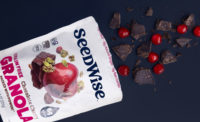Commonly used in a range of bakery applications, including rye and whole-wheat breads, diacetyl tartaric acid ester of mono- and diglycerides (DATEM) can bolster gluten structure, boost volume, elevate springiness, and bring about other benefits. However, the use of DATEM can come at a cost—it lacks sustainability credentials, and the chemical on the label can turn off consumers.
To learn about the ins and outs of DATEM use as well as alternatives, Snack Food & Wholesale Bakery spoke with Paulien Steltenpool, product application expert, baking and confectionery, DSM.
Jenni Spinner: Please tell us about what DATEM is, what it is, and what it’s typically used for in bakery production.
Paulien Steltenpool: DATEM (diacetyl tartaric acid ester of mono- and diglycerides) is a well-known emulsifier and is used to improve consistency, volume, and texture in bread and other dough-based products. Its popularity is partly due to its versatility and processing robustness. DATEM performs well in flour of different qualities and gives consistency in a wide range of applications like wholewheat flour or frozen dough.
JS: What are some of the benefits of using DATEM? You mention elevated dough tolerance for example.
PS: DATEM improves dough tolerance and stability. This is important for industrial bakeries where bread tins are prone to mechanical shock during production. Mechanical shock on a proofed dough leads to loss of gas and collapsed doughs, which results in smaller loaves. By improving stability, DATEM can protect against mechanical shock resulting in a consistent volume of bread.
JS: Then, what are some of the drawbacks and challenges of using DATEM? Please feel free to talk about sustainability, chemicals being unappealing to label-reading consumers, and anything else you find appropriate.
PS: The ongoing conflict in Ukraine has led to ingredient shortages, including seed oils. These are required to create emulsifiers such as DATEM, so shortages are leading to increased prices and making it more challenging for bakers to source DATEM.
DATEM is a synthetic emulsifier made by esterification. This requires a lot of energy to produce which is not cost-effective, particularly with the current volatility in energy prices. DATEM production also creates high quantities of greenhouse gases, making it far less sustainable when compared to alternatives such as enzymes. Additionally, DATEM’s lengthy full name (diacetyl tartaric acid ester of mono- and diglycerides) means that it falls short when it comes to meeting the goals of consumers who are seeking shorter and more recognizable ingredient lists.
JS: For producers looking for DATEM alternatives, could you please talk about what solutions have been offered in the past and what the challenges in finding such alternatives have been?
PS: (Phospho)lipases have become a commonplace (partial) DATEM replacement. During dough processing (phospho)lipases act on wheat flour lipids creating in-situ emulsifiers which provide consistency, volume, and texture in bread and other dough-based products. However, until now, challenges relating to flour quality – particularly those high in free fatty acid (FFA) content – and possible off-flavor formation when using dairy-derived fats meant these alternatives were unable to fully replace DATEM.
These turbulent times have seen uncertainty in both the ingredient and energy markets. Flour is being stored at higher than optimal temperatures and more stock is being bought in. When flour is stored at higher temperatures or for a longer time, the free fatty acid content (FFA) increases due to (endogenous) lipase in the flour. Dough made with this flour is more difficult to stabilize and often results in breads with low volume. Wholewheat flour presents a similar challenge as it is naturally higher in FFAs compared to white flour as it is derived from the whole-wheat granule.
Another big challenge when using (phospho)lipases is off-flavor formation, especially in products that contain dairy-derived ingredients which can be hydrolyzed by (phospho)lipases.
JS: I understand your company is offering DATEM alternatives that address many of the previous concerns bakers have had. Please talk about these solutions, and how they succeed where previous offerings have fallen short.
PS: Over the years, DSM has been developing enzyme solutions as an alternative to DATEM. Producers can use these to lower manufacturing costs and reduce carbon footprint all while maintaining the great taste and texture of baked goods that consumers expect. These (phospho)lipases offer a (partial) DATEM replacement and over the last ten or so years, DSM has introduced solutions such as Panamore Golden and Panamore Spring which have both been commonly used in bread and other dough-based products.
However, we knew these enzymes could do more to improve the more challenging processes and applications, for example, when using flour with a higher free fatty acid content. This has been a growing issue recently following the ongoing conflict in Europe. Longer transport and storage times and higher storage temperatures have reduced the quality of flour as over time endogenous lipases lead to an increase in these FFAs. This ultimately affects the dough stability, leading to lower-quality bread with a smaller volume.
DSM’s answer to this issue is Panamore Xtense. This is a newly developed enzyme and is especially effective when using flours such as white and wholewheat with a higher FFA content. Panamore Xtense can also maintain stability in dough and improve the shape, volume, and crust opening when baking off frozen dough products. It can also prevent the development of flavor off-notes in dairy-derived applications such as brioche. Crucially, Panamore Xtense can also reduce production costs, something particularly important in the current economic climate. It can also boost sustainability when compared to other emulsifiers as lower quantities are needed to establish the same functional effect.










